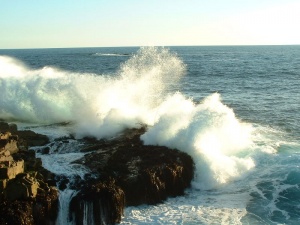Difference between revisions of "Wave Power"
(→Links) |
(→Links) |
||
| Line 32: | Line 32: | ||
* [http://www.gizmag.com/unique-hydro-energy-system-harnesses-slow-water-currents/10439/ VIVACE] | * [http://www.gizmag.com/unique-hydro-energy-system-harnesses-slow-water-currents/10439/ VIVACE] | ||
* [http://www.ceto.com.au/home.php CETO] | * [http://www.ceto.com.au/home.php CETO] | ||
| + | * [http://www.cwavepower.com/index.html C-WAVE Power] | ||
{{Energy}} | {{Energy}} | ||
Revision as of 00:43, 8 January 2010
In the book is a nice collection of ways to get energy from waves.
- Patent for a wave-operated power plant with more links to other patents.
- The energy you can get from waves is (according to Wikipedia):
- ρ = water density (1020 to 1029 kg·m-3 for Seawater)
- g = gravity acceleration (9.81 m/s2)
- H = wave height
Videos
- The West Wave Project
- Wave Hub, 10 miles off Hayle on north coast of Cornwall
- Pelamis Wave Energy Converter
- By Pelamis Wave Power
- CETO - SeaPowerPlan invention
- Hypalon bladders are affixed to a piston that moves inside a tube secured to the seabed. The bladder is a float that rides up and down on underwater wave cycles, and the "piston inside a tube" is a pump that sends high pressure seawater over tubing for remotely generating electricity and/or desalinating the seawater.
- Google Tech Talk
- On wave energy and Pelamis
See also
Links
| Energy |
|---|
| Hydrothermal · OTEC · Wave Power · Currents · Osmotic Power · Energy Storage · Micro-grid · Biofuel · Wind turbines · Kites · Photovoltaics · Nuclear |
